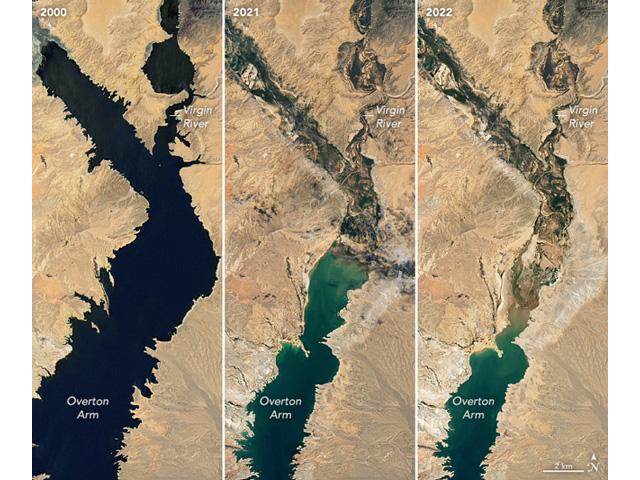DTN Ag Policy Blog
Drought-Stricken West Looks to Mississippi River to Solve Water Woes
With the long-term drought, or essentially the change in climate, and steady decline of water supplies on the Colorado River, residents in states such as California are increasingly suggesting why can't we pipe water to western dams much like we pipe oil now?
This isn't a new debate, but it's a topic that's going to come up more and more as water levels at Lake Mead and Lake Powell continue to shrink.
This past weekend I received an email about an editorial in the Waterways Journal, "Drought Revives Mississippi River Pipe Dreams." The editorial noted the debate going on through columns and letters to the editor in the Palm Springs, Calif., newspaper over the possibility of piping water from the Mississippi River to Lake Powell in northern Arizona.
Looking at nothing more than Google Maps, getting water the Mississippi River to Lake Powell is 1,459-mile journey from Baton Rouge, La.
Debate is heightening as states in the Colorado River are proposing cuts in water use for next year to keep Powell and Mead from reaching critically low levels -- points at which the Glen Canyon Dam could stop generating hydropower. Right now, the Bureau of Reclamation pegs it at nearly a one-in-four chance (23%) that Lake Powell is not generating power in summer 2024.
The two dams also provide drinking water to about 40 million people and irrigate an estimated 5.5 million acres of agriculture as well.
As DTN's Bryce Anderson noted last month, states in the Colorado Basin need to cut between 2 million and 4 million acre-feet of water usage in 2023 to protect the Lake Mead and Lake Powell reservoirs. That amounts to almost 25 percent.
See, "Drought and Demand Keep Shrinking Western U.S. Water Supply," https://www.dtnpf.com/…
P[L1] D[0x0] M[300x250] OOP[F] ADUNIT[] T[]
The back-and-forth in the Palm Springs Desert Sun op-ed page has continued all month about the feasibility of diverting water from the Mississippi River. The column highlighted in the Waterways Journal argued that Louisiana and Mississippi don't need all of the water flowing down the Mississippi River. "All it does is cause flooding and massive tax expenditures to repair and strengthen dikes."
Noting about 4.5 million gallons per second of Mississippi River flow past the Old River Control Structure in Louisiana, the letter writer explains diverting 250,000 gallons per second would alleviate the low water levels at both Lake Powell and Lake Mead in a year and eight months. The letter was written by Don Siefkes of San Leandro, Calif., who also happens to be the leader of the E100 Ethanol Group championing ethanol usage.
"We build a California aqueduct that saved Southern California and a crude oil pipeline across Alaska that were far more difficult than this proposal," Siefkes wrote. https://www.desertsun.com/…
The responses have been coming ever since. Some Midwesterners and others have written "less than friendly replies," noted another letter to the editor the Desert Sun that advocated for desalinization of water out of the Pacific Ocean.
Still, the Palm Springs paper isn't the only one where people are weighing in. In letter to the San Diego Union-Tribune about the federal government's push to cut water usage, noting "these cuts would be long-term, and not at all in the best interests of the region.
"An alternative and better, long-term solution would be to supplement the Colorado with water piped in from annually-flooded areas in the Midwest, the South and the East. We pipe oil across the country, so there's no reason why we can't pipe water."
https://www.sandiegouniontribune.com/…
Circle of Blue, which reports on water policy, also weighed in on the chances of diverting the Mississippi River. https://www.circleofblue.org/…
The Waterways Journal noted talks to tap the Mississippi River for western states goes back decades. "The Bureau of Reclamation did a thorough study of the idea of pumping Mississippi River water to Arizona in 2012, concluding that the project would cost $14 billion (in 2012 dollars) and take 30 years to complete. As recently as 2021, the Arizona state legislature urged Congress to fund a technological and feasibility study of a diversion dam and pipeline scheme to harvest floodwater from the Mississippi River to replenish the Colorado River."
Farmers and others in western Kansas have had discussions going back several years about tapping into the Missouri River for a canal that would send water to a western Kansas reservoir. In 2015, the Kansas Water Office and U.S. Army Corps of Engineers updated a 1982 study looking at diverting Missouri River water. A 360-mile canal from northeast Kansas to Utica Lake in western Kansas would cost between $5 billion to $19 billion to build, depending on the size of the aqueduct needed.
As the realities of climate change and water use continue to sink in, it's very likely there will be more proposals on the table for canals and pipes from the Midwest to the West, and it won't just come from letters to the editor.
Waterways Journal editorial https://www.waterwaysjournal.net/…
Chris Clayton can be reached at Chris.Clayton@dtn.com
Follow him on Twitter @ChrisClaytonDTN
(c) Copyright 2022 DTN, LLC. All rights reserved.




